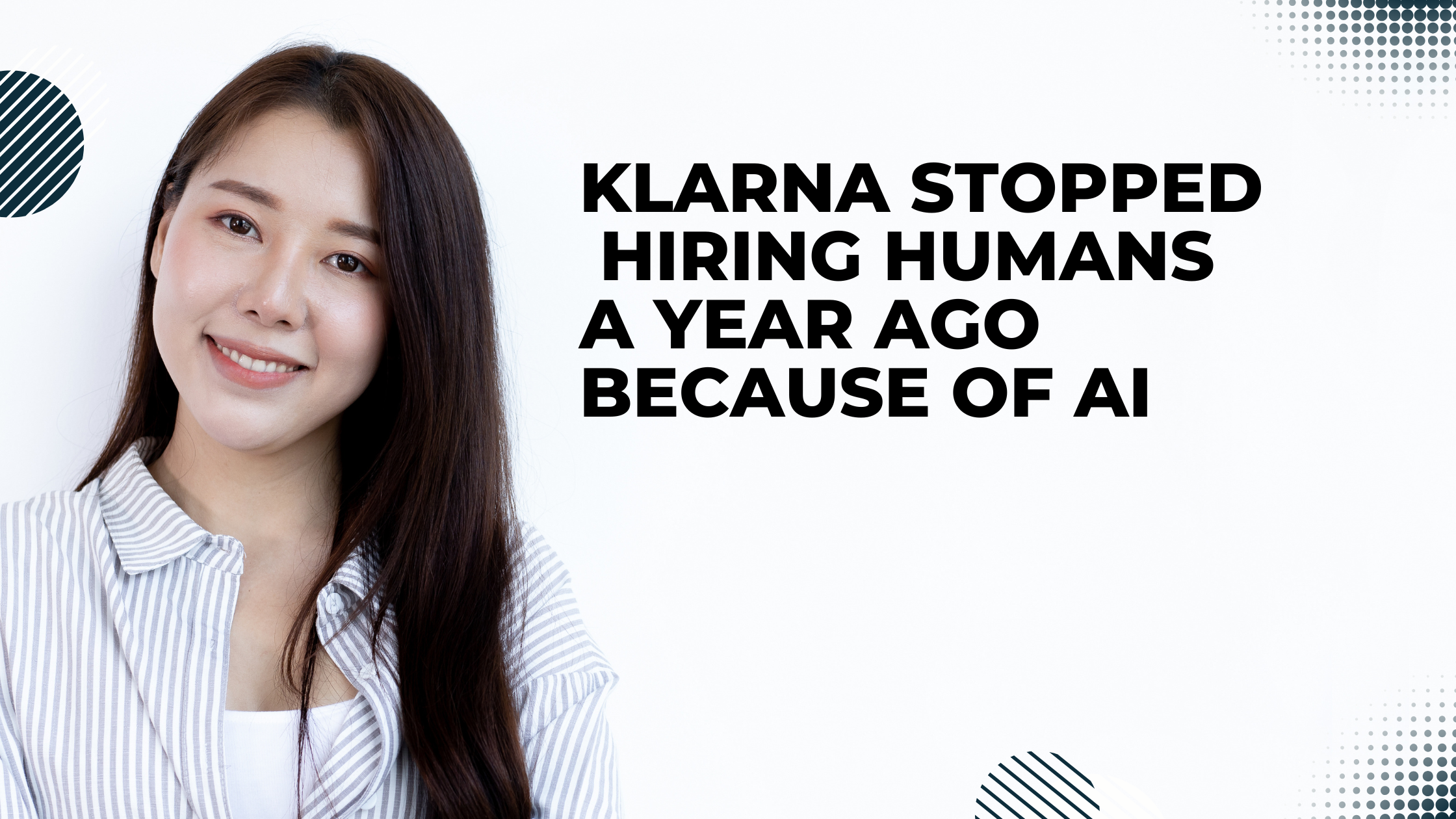Klarna Stopped Hiring Humans A Year Ago Because Of AI
Klarna, a Swedish fintech giant, has reshaped its workforce strategy, leveraging artificial intelligence (AI) to replace traditional roles. Over the past year, Klarna’s CEO Sebastian Siemiatkowski has revealed bold measures, resulting in no new hires and a gradual reduction in its human workforce. Klarna Stopped Hiring Humans A Year Ago Because Of AI. This dramatic shift showcases the growing influence of AI in white-collar industries.
AI Driving Workforce Reduction
Klarna has also decided to cease employing humans as AI’s productivity gradually increases. During his speech Siemiatkowski underlined that AI can currently offer solutions for many activities that were previously made by a person. It set off 1000 employees and this makes the number to be 3500 from 4500 in one year. This reduction happened over the years due to attrition as people take an average five-year stint at Klarna. Without a possibility of new hires, Klarna ‘s workforce reduces by 20% every year.
Despite fewer employees, Klarna has maintained its productivity. This success stems from AI deployment across key operations, such as customer support. In March, Klarna introduced an AI assistant handling tasks previously performed by 700 employees. The assistant cut query response times from 11 minutes to 2 minutes, improving efficiency and reducing repeat queries by 25%.
Upside for Remaining Employees
Interestingly, Klarna’s use of AI benefits its remaining workforce. Siemiatkowski outlined how cost savings from AI are being redirected to increase employee salaries. “The total salary cost of Klarna is shrinking, but part of the gains will show in employees’ paychecks,” he explained.
This model has motivated Klarna employees to embrace AI in their roles. By deploying AI tools to improve efficiency, workers see direct financial rewards in higher salaries and equity compensation. This innovative approach highlights how AI adoption can balance workforce reductions with enhanced benefits for those who remain.
Klarna’s Scale and the Future of Jobs
Klarna operates on a massive scale, managing 2.5 million daily transactions, serving 85 million customers, and partnering with over 5.75 lakh merchants. Despite its vast operations, the company relies heavily on AI to handle workloads previously managed by human employees.
The triumph of AI use in Klarna indicates a new dawn in the destruction of the mid-level white-collar position. If big companies are able to cut on their staff by 20% on a yearly basis while still increasing efficiency then there could be a big impact on job markets across the world. AIs have gone past simple low-level tasks to entering fields like customer relations and even making decision making roles.
A Wake-Up Call for the Workforce
Klarna’s journey raises essential questions about the future of work. AI’s ability to perform human roles at scale suggests that many white-collar jobs could soon face similar disruptions. Companies may follow Klarna’s lead, reducing staff while increasing efficiency and profitability.
However, Klarna’s example also demonstrates how AI-driven changes can benefit employees. By adopting AI, companies could redirect savings towards higher salaries and better equity plans. Yet, the broader workforce must adapt to these shifts by learning AI skills and embracing technological advancements.
You can read more information related to Startup advise, AI and startup news here.
Thanks
1. What is Klarna?
Klarna is a Swedish fintech company that provides buy now, pay later (BNPL) services and other payment solutions.
2. When was Klarna founded?
Klarna was founded in 2005 by Sebastian Siemiatkowski, Victor Jacobsson, and Niklas Adalberth.
3. Where did the founders of Klarna meet?
The founders of Klarna met while working at Burger King.
4. What services does Klarna offer?
Klarna offers buy now, pay later services, interest-free payments, and financing options for larger purchases.
5. How many countries does Klarna operate in?
Klarna operates in 26 countries around the world.
6. How many merchants does Klarna work with?
Klarna works with over 575,000 merchants globally.
7. How many transactions does Klarna handle daily?
Klarna handles about 2.5 million transactions every day.
8. Is Klarna planning an IPO?
Yes, Klarna has filed for an initial public offering (IPO) in the US and is expected to be one of the biggest IPOs of 2024[1][4].
9. What is Klarna’s current valuation?
Klarna’s current valuation is around $14.6 billion[1][4].
10. Why has Klarna stopped hiring new employees?
Klarna has stopped hiring new employees due to its increased use of artificial intelligence (AI) to improve efficiency[2].
11. How has Klarna’s workforce changed in the past year?
Klarna’s workforce has reduced by 22% to 3,500 employees over the past year due to natural attrition and no new hires[2].
12. How is AI impacting Klarna’s workforce?
AI is performing tasks previously done by humans, leading to a reduction in the workforce. However, it also increases efficiency and allows for higher salaries for remaining employees[2].
13. What is an example of AI’s impact on Klarna’s operations?
An AI assistant at Klarna is doing the work of 700 employees, handling customer service chats and reducing response times significantly[2].
14. How does Klarna benefit its remaining employees through AI?
Klarna is redirecting cost savings from AI to increase salaries and provide better equity compensation for its remaining employees[2].
15. What is the impact of AI on job markets according to Klarna’s example?
Klarna’s use of AI suggests that many white-collar jobs could face disruptions as companies adopt similar strategies to reduce staff while increasing efficiency[2].
16. Has Klarna expanded its BNPL services recently?
Yes, Klarna has expanded its BNPL services to new European markets through its partnership with eBay[3][7][9].
17. Which new markets is Klarna offering its BNPL services in?
Klarna is now offering its BNPL services in the UK, Austria, France, Italy, the Netherlands, and Spain, among other markets[3][7][9].
18. What types of payment options does Klarna offer?
Klarna offers interest-free pay in 3, pay in 30 days, and financing options for larger purchases with monthly repayments[3][7].
19. Why was Klarna fined by the Swedish Financial Supervisory Authority?
Klarna was fined $46 million for violating anti-money laundering regulations[5][10].
20. What were the specific violations that led to the fine?
Klarna’s general risk assessment had significant deficiencies, and it lacked procedures for due diligence measures for customers using its invoice product[5][10].
21. How is Klarna responding to the fine?
Klarna is committed to combating money laundering and terrorist financing and will continue to work with authorities to improve its compliance[5].
22. What is Klarna’s financial performance recently?
Klarna reported a net income of SEK 216 million in Q3 2024, up 57% year-over-year[6].
23. Is Klarna profitable in its US operations?
Yes, Klarna has achieved profitability in the US, which was a key milestone before its planned IPO[1].
24. How long did it take Klarna to become profitable in the US?
Klarna became profitable in the US within five years of its launch there[1].
25. What is the future outlook for Klarna’s use of AI?
Klarna is expected to continue its focus on AI to drive efficiency and innovation, potentially leading to further changes in its workforce and operations[2].
Thanks





